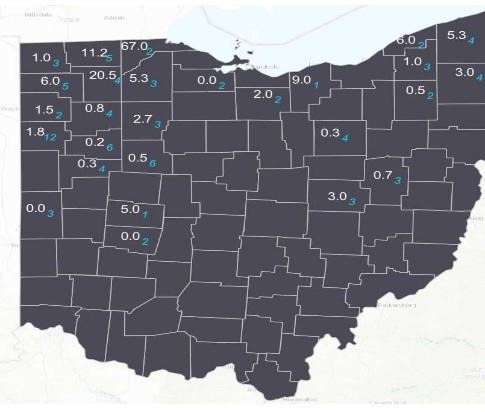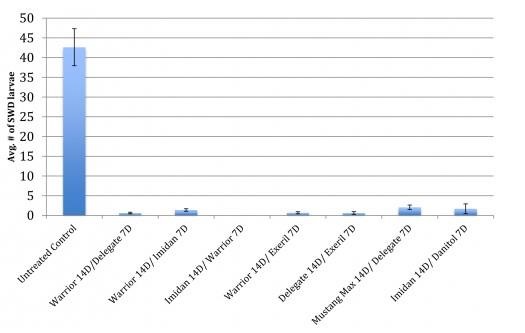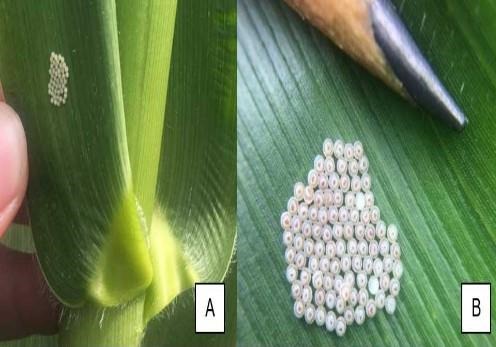By Amy Raudenbush and Suranga Basnagala et.al
Western bean cutworm (WBC) numbers for the week ending July 11 have increased to the point where scouting for egg masses is recommended in Fulton, Henry, Lorain and Lucas counties. Traps were monitored from July 5 – 11 and resulted in a statewide average of 3.9 average moths per trap, though higher in the counties noted; Figure 1).

Figure 1. Average Western bean cutworm adult per trap (in white) followed by total number of traps monitored in each county (in blue) for week ending July 11, 2021. Map developed by Suranga Basnagala, Ohio State University, using ArcGIS Pro.
We used growing degree day calculations to predict approximate percentage of adult WBC flight as of Sunday July 11th (Figure 2). At this time, the majority of counties in NW Ohio are seeing approximately 25% adult flight, whereas counties in central and NE Ohio remain at 10%. Once GDD numbers accumulate to 2704, approximately 50% of WBC flight will have occurred. For more information on calculating GDD and WBC please see the following article: https://cropwatch.unl.edu/2021/degree-days-prediction-western-bean-cutworm-flight

Figure 2. Growing degree day GDD accumulations from March 1, through July 11, 2021. Locations with red GDD accumulation numbers indicate approximately 25% Western bean cutworm (WBC) adult flight has occurred. Locations with blue GDD accumulation numbers have reached approximately 10% adult WBC flight. Map developed by Aaron Wilson, Ohio State University.
Scouting guidelines
Counties with adult WBC trap counts averaging 7 or more moths per week should begin scouting for WBC egg masses in corn fields that are pre-tassel approaching tassel. Freshly laid egg masses are white and turn a purplish color as they mature (Figure 3), close to hatch. To scout, randomly choose at least 20 consecutive plants in 5 locations within a field (a total of 100 plants per field). Inspect 3–4 leaves on the uppermost portion of the corn plant. It is very useful to look at leaves with the sun behind them – often the shadow of the egg mass will reveal it without having to examine the leaf closely. Field corn should be treated with a foliar treatment if more than 5 % of inspected plants have eggs or larvae. Sweet corn should be treated if more than 4 % of inspected plants have eggs or larvae (processing market), or 1 % of plants (fresh-market). For more scouting information, view our WBC scouting video https://aginsects.osu.edu/news/western-bean-cutworm-video
Treatment
If the number of egg masses/larvae exceed the threshold mentioned above, foliar applications of insecticides are available, especially those containing a pyrethroid. Timing an insecticide application is critical and must happen before the caterpillar enters the ear, but after the eggs hatch. If the eggs have hatched, applications should be made after 95% of the field has tassels. If the eggs have not hatched, monitor the egg masses for the color change. Newly laid egg masses will be white but turn purple as they mature. Hatch will occur within 24–48 hours once eggs turn purple.

Figure 3. A) Western bean cutworm egg mass on upper leaves of corn plant. B) Close up of WBC egg mass, pencil for scale.
Source : osu.edu